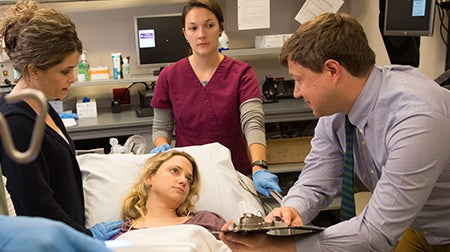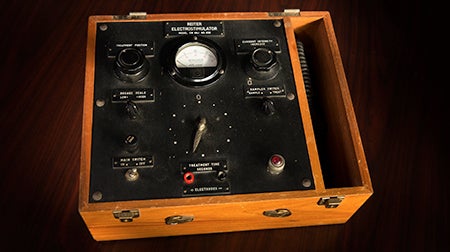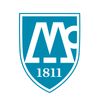By Stephen J. Seiner, MD, and Terry A. Bragg, MSLS, MA
Electroconvulsive therapy (ECT) is used to treat patients with certain types of mental illness, including severe depression, severe mania, and catatonia. It was first developed in the late 1930s, with the first recorded treatments at McLean Hospital taking place in 1941.
A few years prior to the advent of ECT, many hospitals, including McLean, used chemically induced seizures as a method to treat patients with severe mental illness. Insulin therapy and metrazol therapy were both started at McLean in 1938, but discontinued in 1941—although such therapies continued for many more years at some other hospitals. McLean doctors at the time determined that ECT was a more precise and less risky treatment.
Chemical seizure therapy required the injection of potentially toxic substances into the body, and the experience was very unpleasant for patients. Because of uncertainty about proper dosing, the patient had to wait for the seizure to come on as the chemical treatment was slowly administered, making the procedure very anxiety provoking.
ECT, on the other hand, produced an instantaneous and reliable seizure. Patients also had no recollection of the seizure, and they therefore had less fear about the procedure after it was completed.

McLean’s ECT Service treats patients with an array of psychiatric illnesses including severe and treatment resistant depression
Aside from these advantages that helped make ECT a more tolerable experience, ECT proved early on to be a very effective treatment for certain forms of mental illness, including depression. In 1945, McLean Hospital Psychiatrist in Chief Kenneth J. Tillotson, MD, and Wolfgang M. Sulzbach, MD—the first physicians to perform ECT treatments at McLean—published one of the earliest follow-up controlled studies on ECT, “A Comparative Study and Evaluation of Electric Shock Therapy in Depressive States.” The study compared 70 patients with depression who were treated with ECT to a control group of 68 patients with depression who were not given any treatment. The researchers found that 80 percent of the patients treated with ECT experienced symptomatic improvement, versus only 50 percent of the control group; one year after discharge, 17 percent of the treated patients had relapsed as compared to 40 percent of the untreated patients; and the average length of hospitalization for the treatment group was 5 months and 9 days, as compared to 21 months for the control group. Interestingly, in terms of side effects they noted:
“Although mild amnestic and confusional syndromes were frequently encountered for a few hours to two weeks after four or more treatments, we have never observed any real or persistent deterioration in any of our patients, whereas the opposite was seemingly true in some patients, who subsequent to shock therapy displayed a far more efficient intellectual as well as emotional adaptability to their environment than ever before in their life.”
Many other studies demonstrating ECT’s efficacy followed. However, ECT was slow to gain acceptance, partly because ECT was such a radical departure from the way things had been done for many years. It was a very straightforward and inexpensive procedure that could be used to treat a patient in a relatively short period. In contrast, the public and those in the psychiatry field itself were accustomed to the notion of treatment as a series of one-hour sessions of psychotherapy spread out over a long period, and they were troubled by the idea of applying electricity to the brain.
In the 1950s and 1960s, the widening adoption of modified ECT—which includes the use of a muscle relaxant and general anesthesia—helped bolster acceptance of the treatment. The muscle relaxants eliminated the convulsions associated with seizures and therefore greatly reduced the risk of injuries. (After experimenting with curare, a natural, plant-derived muscle relaxant, in the 1940s, physicians switched to a safer, synthetic muscle relaxant in the 1950s.) The anesthesia, meanwhile, made the procedure more comfortable for the patient and made it easier for the clinician to administer the muscle relaxant.
Another positive shift took place during the 1960s and 1970s, when practitioners moved from using sine-wave machines to brief-pulse devices. This change reduced reports of cognitive side effects associated with ECT treatment.
Around the same time, an antipsychiatry movement—partially fueled by the negative portrayal of ECT in “One Flew Over the Cuckoo’s Nest”—served to diminish the view of ECT in the public eye. Since that time, however, thanks to increased awareness and further treatment advances, ECT has made a steady comeback.
Physicians, for instance, have recently moved toward greater use of unilateral ECT, in which electric current is applied to only one hemisphere of the brain, as opposed to both sides of the brain in bilateral ECT. While bilateral is still considered to be the gold standard (i.e., the most powerful) ECT treatment, studies have shown that unilateral ECT can be nearly as effective at reducing symptoms of mental illness while producing fewer cognitive side effects. Furthermore, about 10 years ago, a newer type of ECT called ultrabrief pulse was shown to be very effective and resulted in even less memory loss. This type of ECT has since become very popular, including at McLean Hospital, and has helped dramatically reduce memory impairment associated with the procedure for many patients.

From the Archives: This device was used in early delivery of electroconvulsive therapy. Modern ECT devices utilize cutting-edge technology and the latest in health care advances.
Other improvements include greater uniformity of informed consent across institutions, an increasing number of national locations at which clinicians can get specialized ECT training, the development of a comprehensive textbook on how to administer ECT, greater standardization of care, and advances in anesthesia dosing and medical monitoring. With all these advances, what was once an effective and safe treatment is now a more effective, more comfortable, and safer treatment.
Here at McLean Hospital, we now perform four times as many ECT treatments as we did in the late 1990s, and we are using the procedure to treat a broader population of patients—and not just as a last resort. This is good news, as it suggests that people are becoming increasingly aware of the safety and significant healing potential of ECT.
Stephen J. Seiner, MD, is director of the Psychiatric Neurotherapeutics Program, the Electroconvulsive Therapy (ECT) Service, and Medical Student Education at McLean Hospital. Dr. Seiner’s clinical interests include neurotherapeutics and geriatric psychiatry.
Terry A. Bragg, MSLS, MA, has served as McLean Hospital’s archivist since 1981, when he was recruited to establish an institutional archive. He has also been director of Professional Staff Affairs since 1983, a role that includes the management of professional staff credentialing and academic appointments.
McLean’s ECT Service performs over 7,000 treatments a year, making it one of the largest ECT centers in the country. To learn more about ECT, visit McLean’s Guide to ECT Treatment.
If you are concerned about your own well-being or that of a loved one, you can take an anonymous and confidential mental health screening online.
